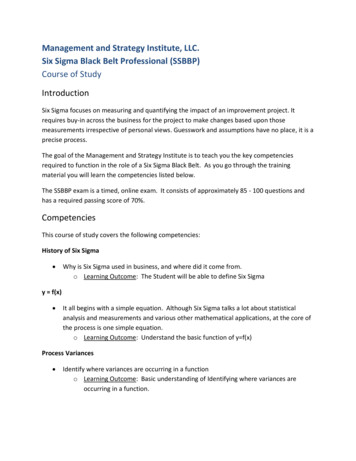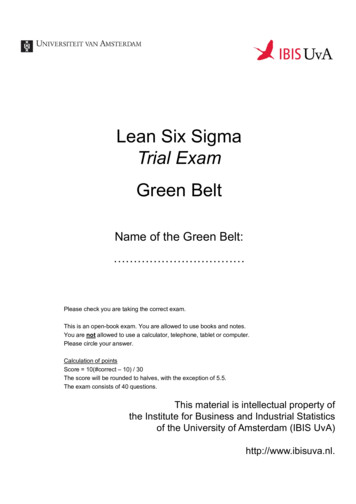
Transcription
International Journal of Humanities Social Sciences and Education (IJHSSE)Volume 1, Issue 8, August 2014, PP 123-138ISSN 2349-0373 (Print) & ISSN 2349-0381 (Online)www.arcjournals.orgAn Analysis of Historically Black Colleges and UniversitiesStudent Retention and Attrition EffortsLinda Knight Ph.DGraduate Studies and Research469 Tucker Hall,Florida A&M University, Tallahassee,linda.knight@ famu.eduElizabeth Davenport, J.D., Ph.D309-A Gore Educational Center-AFlorida A&M University, Tallahassee,elizabeth.davenport@famu.eduPatricia Green- Powell, Ph.D300-A Gore Educational Center-AFlorida A&M University, Tallahassee,patricia.greenpowell@famu.eduAdriel A. Hilton, Ph.DAssistant Professor and Director of the College Student Personnel Graduate Program atWestern Carolina University in Cullowhee, NC.Linda G. Knight received her Bachelor of Arts, Masters of Art sand Ph.D. from Florida A&M University.Dr. Knight currently serves as the Associate Vice President of Enrollment Management for the Division ofStudent Affairs at Florida A&M University (FAMU). Prior to this, Dr. Knight was the Director ofFellowship Programs, Recruitment & Academic Affairs at the School of Graduate Studies and Research(SGSR) at FAMUElizabeth K. Davenport is a Professor of Educational Leadership at Florida A&M University. She holds aPh.D. in Curriculum, Teaching and Educational Policy from Michigan State University, as well as lawdegrees from The University of Michigan and New York University. In addition she holds Master‘s degreesin Telecommunications Management and Higher Education, Adult, and Lifelong Learning. Her researchagenda concerns educational law, policy, and curriculum.Patricia A. Green-Powell, Ph. D., currently serves as Associate Dean for Student Services and AssociateProfessor in the Department of Educational Leadership, College of Education at Florida A&M University(FAMU).Previous leadership roles at postsecondary institutions include Vice President for Student Affairsat FAMU and at Bainbridge College in Bainbridge, Georgia.Adriel A. Hilton serves as executive assistant to the President and chief diversity officer & assistantsecretary to the Board of Trustees at Upper Iowa University—a worldwide institution with a traditionalcampus in Fayette, Iowa and more than 20 locations in the U.S. and abroad. Prior to this appointment,Hilton worked as the inaugural public policy fellow in the highly competitive fellowship program at theGreater Baltimore Committee.Abstract: The purpose of this study was to identify persistence factors that influenced African Americandoctoral students’ completion at selected historically Black colleges and universities (HBCUs) in theSouthern region of the United States. The conceptual framework for this study includes an integration oftheoretical constructs from four widely utilized and tested theories of undergraduate student persistenceguided by the theoretical framework of student motivation, student choice, and student persistence. Datawere collected utilizing a Likert scale survey, the Doctoral Student Persistence Survey which assessed theperceptions of doctoral students as to factors which promote persistence and those perceived barriers forstudent success. ARCPage 123
Linda Knight PhD et al.Keywords: retention, attrition, graduate, historically Black college and universityAn Analysis of Graduate Student Retention and Attrition Efforts at Selected Historically BlackColleges and Universities in the Southern Region of the United States1. INTRODUCTIONResearch universities in the United States are internationally known as the foremost institutions ingraduate education. With this reputation, research institutions have recruited students of allnationalities, ethnic groups, and religions for their student population. However, in the UnitedStates, graduate schools have been less successful in recruiting the minority population whichincludes: Hispanics, African Americans, Asians, and Native Americans. In fact, the proportion ofminority students in higher education declines as one moves from baccalaureate to master‘s todoctoral degree programs, and at each level the percentage is well below the percentage of theseindividuals in the U.S. population (American Council on Education, 2003). Simultaneously, thenation's minority population is steadily rising and now makes up 35 percent of the United States,illustrating a trend that could make minorities the new American majority by 2050.New Census Bureau data estimates that minorities added more than 2 percent in 2009 increasingto 107.2 million people, due to Hispanic births and more Americansdescribingthemselves asmultiracial. During this time, the White population remained flat, making up roughly 199.9million, or 65 percent, of the country. Just ten years ago, Whites comprised 69 percent of the totalpopulation and minorities 31 percent. Currently four states – Hawaii, New Mexico, California andTexas – as well as the District of Columbia have minority populations that exceed 50 percent(Census Bureau, 2010). Such demographic changes in the nation will be reflected in the graduatestudent population.In the last decade, African Americans have made advances in doctoral degrees (National ScienceFoundation [NSF], 2007). From 1996 to 2006; the number of African American doctoralrecipients increased 27%. In that same period, the total numberof Ph.D.s conferred by all UnitedStates universities increased by 8%. In the last twenty years, the number of African Americanswho received doctorates in science and engineering has more than doubled (National ScienceBoard, 2008). While graduate schools have made great efforts to increase graduate enrollment anddegree success for African American students, HBCUs have led the increase in the number ofAfrican American doctoral degree holders.Another factor fueling this increase was affirmative action programs created by colleges anduniversities during the late 1960s and 1970s, largely to comply with Title VI of the Civil RightsAct of 1964, which prohibits several types of discrimination in student recruitment, admissions,and financial aid (Ervin & Davenport, 2007). This growth was aided by the Supreme Court‘sdecision in Regents of the University of California v. Bakke (438 U.S. 265, 1978), which allowedrace to be a determinant in the admission to graduate schools. Preferential race-based programswere developed partly in response to the demands to improve the graduation rates of minoritystudents at Traditionally White Institutions (TWIs).The perceptions of barriers and strategies for the recruitment and retention of diverse graduatestudent population of college and university administrators and others who are responsible forrecruitment and retention of the graduate student population are critical players for creatingchanges in higher education during the 21st century. Therefore, the purpose of this study was toidentify persistence factors that influenced African American doctoral students‘ completion atselected historically Black colleges and universities (HBCUs) in the Southern region of theUnited States. The conceptual framework for this study includes an integration of theoreticalconstructs from four widely utilized and tested theories of undergraduate student persistenceguided by the theoretical framework of student motivation, student choice, and studentpersistence.2. BACKGROUNDThe Higher Education Act of 1965 defined an HBCU as any historically Blackcollege oruniversity, established prior to 1964, whose principal mission was, and is, the education ofAfrican Americans. These educational institutions are accredited by a nationally recognizedInternational Journal of Humanities Social Sciences and Education (IJHSSE)Page 124
An Analysis of Historically Black Colleges and Universities Student Retention and Attrition Effortsaccrediting agency or association, as determined by the United States‘ Secretary of Education tobe a reliable authority as to the quality of training offered or is, according to such an agency orassociation, making reasonable progress toward accreditation HBCUs were founded during an erawhen African American students were barred from attending traditionally white, postsecondaryinstitutions.TheCivil Rights Movement opened the doors of traditionally White colleges anduniversities to minority students, some policymakers have challenged the relevance of HBCUs,arguing that they serve no purpose in an integrated system of higher education. Of the 105 HBCUinstitutions in America today, 27 offer doctoral programs and 52 provide graduate degreeprograms at the Master's level.However, HBCU graduate programs continue to help promote campus diversity nationallyas aresult of assaults to affirmative action. In1996, California voters passed Proposition 209. Theinitiative prohibits discrimination against or preferential treatment for any individual or group inpublic employment, education, or contracting on the basis of race, sex, color, ethnicity, or nationalorigin (Ervin & Davenport, 2007). Voters in Washington State followed suit in 1998, and votersin Texasaccepted similarinitiativesaswell (Chang,Witt,Jones,&Hakuta,2000)Meanwhile,Grutter v. Bollinger (539 U.S. 306 (2003), acase in which the UnitedStatesSupreme Court upheld the affirmative action admissions policy of the University ofMichigan Law School, 5-4 decision , was overturned by a referendum of Michigan voters.Therefore, today although HBCUs represent only 4% of all colleges and universities in the U.S.,they account for nearly one-quarter of theAfrican American bachelor‘s degree recipients (Redd,2000).HBCUs have been increasing their involvement in graduate education and since 1996 moreHBCUs have begun to offer doctoral programs. Prior to 1996, less than one-quarter of the 87four-year public and private HBCUs awarded doctorates.By 2006, the percentage of HBCUs withdoctoral programs grew to 32%, with just under fifty percent of the four-year public historicallyBlack institutions offering such programs. The increase in HBCUs offering doctorates and thenumber of graduate students attending these programs has led to a rapid growth in the number ofAfrican Americans receiving Ph.D.s and other doctoral degrees in the past five years. In fact, thepercentage increases in African American doctorates from HBCUs appears to have accelerated,while thenumber ofthese awards overall has slowed.The enrollment of African Americans and students of color in graduate programs is one of manyproblems facing this country. A lack of minority graduate students in the educational pipelinemeans a lack of minorities in higher education and despite minimal gains recruiting, retaining, andgraduating minority students in graduate programs, a problem still exists in the graduation ofdoctoral students, and many universities are searching for innovative strategies to increaseretention and graduation of African American students. As the overall color scheme of theFlagship and Research I institutions across thenation has become more Asian and White, AfricanAmerican graduates and people of colorare being displaced (Hale, 2006). Therefore, this furtherhighlightsthe importance of additional examination of issues related to retention and graduationrates of African Americans at HBCUs. Because of this growing trend, HBCUs have become arefuge of last resort for graduate exploration of many African Americans and people of color(Garibaldi, 1984).Table 1. Percentages of Change in Doctoral Degrees Awarded to African Americans at HBCU Comparedwith All U.S. UniversitiesHBCUs*All 682%27%*Includes awards to U.S. Citizens and permanent residents only Source CGSNER. ORGHale (2006), stated: ―Black institutions of higher education have assumed the burden ofresponsibility for those students who have hungered for knowledge and the opportunity to gain it‖(p. xvii).Therefore, the question this society must ask itself is, if HBCUs do not ―do it right,‖thatis retain, adequately prepare and graduate minority students, who will do it? (Hale, 2006).HBCUsnow more than ever have an even more important role in society through the education of AfricanAmerican graduates prepared and ready to compete in the global market.International Journal of Humanities Social Sciences and Education (IJHSSE)Page 125
Linda Knight PhD et al.3. RETENTION AND ATTRITION THEORETICAL MODELSRetention in post-secondary education is described as activities or programs which reducesstudent dropout rates and enhance the institution‘s overall graduation rates (Pascarella &Terenzini, 1991). However, there exists a vast array of literature on student retention and attritionin general; over the past half century. According to Pascarella and Terenzini (1991), numerousstudies such as Bean and Metzner's (1985) Nontraditional Student Attrition Environmental, wherethey discovered environmental factors have a greater impact on departure decisions of adultstudents than academic variables.Kamens (1971, 1974), used multi-institutional data todemonstrate how colleges of greater size and complexity had lower attrition rates. McNeely(1973)"College Student Mortality", examined many factors in college student retention includingtime to degree, when attrition was most prevalent in a student's education,and impact of collegesize Spady Model (1971) studied the interaction between student characteristics and campusenvironment; all conducted to relate the affects of colleges themselves on the retention, attritionand graduation of students. Among them the most noted have been Tinto‘s Student IntegrationModel (SIM, 1975, and 1997); Astin‘s Student Involvement Theory (SIT, 1984); Bean‘s StudentAttrition Model (SAM, 1982,1983,1985, and 1990); and, Padilla‘s Expertise Model of SuccessfulStudents (EMSS, 1991, and 1994).4. TINTO’S STUDENT INTEGRATION MODELTinto (1975)developed the Student Integration Model (SIM) of attrition (see Figure 1). Thismodel was to offer an explanation of the aspects and procedures that influenced an individual‘sdecision to leave an institution, and how these processes interact to ultimately produceinstitutional attrition. Tinto‘s SIM model was based solely on Durkheim‘s (1897) theory ofsuicide (McCubbin, 2003). According to McCubbin (2003), Durkheim‘s theory was founded inthe likelihood of someone committing suicide being predicated on the level of their integrationinto society as a whole.Durkheim (1897) argued that if an individual has an adequate support network and sufficientmoral integration that the likelihood of them committing suicide is reduced tremendously. To thisassertion, Tinto (1975) interjected that the act of committing suicide was basically the willfulwithdrawal from existence by individuals, and, therefore, was equivalent to dropping out ofhigher education, which was the willful withdrawal by an individual from one aspect of society.Durkheim concluded that the reason an individual commits suicide is because he or she are notsufficiently integrated into society. Conversely, Tinto (1975) asserted the reason for dropping outis a result of the individual‘s insufficient integration into the different aspects of college oruniversity life (Tinto, gDrop outDecisionFigure 1. Tinto’s Student Integration Model (1975).International Journal of Humanities Social Sciences and Education (IJHSSE)Page 126
An Analysis of Historically Black Colleges and Universities Student Retention and Attrition EffortsAccording to Tinto (1975), the two most important means of student integration in a college oruniversity are the institution‘s academic and the social systems. Tinto asserted that a student‘sreasoning for dropping out occurs through the lack of or extreme integration into either or bothsystems. Tinto asserted that if a student expends a great amount of time studying that his or hersocial skills suffer and vice versa. He further indicated that if a student spends a large amount oftime on social activities and not enough time dedicated to studying or academics, then his or hergrades reflect it. Unlike Durkheim‘s (1897) model, Tinto‘s (1975) model, according to McCubbin(2003), failed to take into account the individual‘s psychological predisposition in the decision towithdraw.Key features of Tinto‘s SIM model included the degree of integration in the institution‘s academicand social systems, and the student‘s commitment tothe institution itself and his or her individualgoals (the enrollment commitment). Tinto (1975) pointed out a number of characteristics whichaffect the student‘s pre-enrollment commitment. These include individual attributes which includerace, sex and academic ability. Pre-college experiencesinclude a student‘s grade point average,academic and social recognitions, andfamily background, (i.e., socioeconomic status, familyvalues, climates and cultural backgrounds (Tinto, 1975).Included also in this model are an individual‘s educational expectations, which drive the student‘sselection of educational institutions. This researcher stated that becauseeach student viewsselection of an educational institution as pivotal to future success, commitment to that institutionpersistence is greatly enhanced. A student‘s assessment of their post secondary experience comesin the form of cost benefits analysis. According to Tinto (1975), if the studentdetermines that thecost benefit is high, the likelihood is that the individual will persist, and on the other hand, if he orshe concludesthat the cost benefit analysis is low, then it is more likely to cause dropout orwithdrawal.Tinto asserted that persisters and non-persisters view educational processes differently. Nonpersisters see education as a vocational process andpersisters view it as an intellectual gain. Hemakes a direct link of attrition to social integration, stating that it likely leads to voluntarywithdrawal rather than academic dismissal. Social integration within the faculty is one of its mostimportant aspects.According to Tinto, interaction with faculty not only increases the student‘slevel of social integration, but it also leads to increased academic integration which translates toincreased academic performance by the student.Tinto‘s (1975) student integration model illustrates his premise that academic and socialintegration, individual goal and institutional commitment are intertwined in a student‘s decision topersist. He asserted that academic integration has a direct impact on a student‘s individual goalcommitment and commitment to his or her chosen institution is directly affected by his or herability to socially integrate.While Tinto‘s SIM (1975) has been widely accepted for more than twenty years, according toMcCubbin (2003), several criticisms exist. McCubbin stated that the criticisms revolve aroundTinto‘s SIMare ―(a) inadequate in modeling student attrition; (b) only applicable to ‗traditionalstudents‘; and, (c) academic integration is not an important predictor of student attrition intraditional student populations.‖The criticism that SIM is inadequate in modeling student attrition stems from research conductedby Brunsden, Davies, Shevlin and Bracken in 2000. In their study, Brunsden et al. (2000)administered a questionnaire to first year students to assess the validity of Tinto‘s model. Theyfound that global application of the model provedimpossible to assess its individual components.However, Brunsden et al. (2000),in their assessment and criticism, did indicate possibleshortcomings of their own study, since they did not actually assess social or academic integration,only the potential of these characteristics (Brunsden et al., 2000). They also openly criticizedTinto‘s reliance on Durkheim‘s model of s
Student Affairs at Florida A&M University (FAMU). Prior to this, Dr. Knight was the Director of Fellowship Programs, Recruitment & Academic Affairs at the School of Graduate Studies and Research (SGSR) at FAMU Elizabeth K











